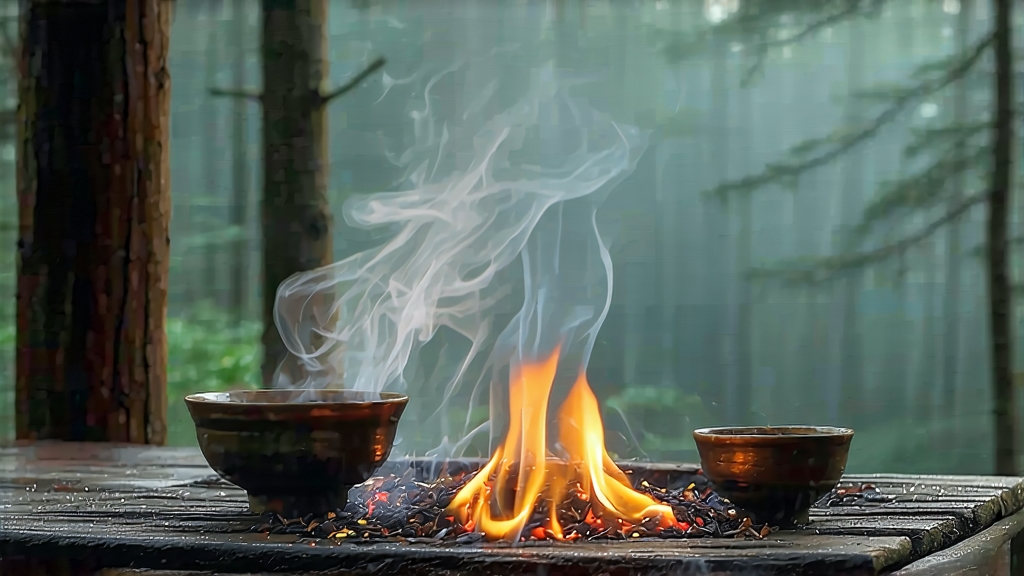
Long before Assam, Ceylon, or Earl Grey entered the Western lexicon, the first fully oxidised leaf that would later be called “black tea” was born in the rugged Wuyi Mountains of northern Fujian. Locals still use its original name—zhengshan xiaozhong—literally “small leaf from the original mountain,” but the outside world knows it as Lapsang Souchong. This is the tea that sailed out of the port of Xiamen in 1604 aboard Dutch merchant ships, astonishing European palates and setting off a two-century craze that would redraw global trade routes. Today, while mass-market smoked teas are often reduced to a tarry fragrance in a teabag, the authentic leaf still carries the cool mountain air, the resinous breath of Masson pine, and the quiet patience of farmers who refuse to hurry smoke.
History: From Bandit Refuge to London Drawing Rooms
The Wuyi range is a UNESCO World Heritage labyrinth of basalt cliffs and subtropical forest. During the late Ming dynasty, passing armies forced tea makers to delay leaf processing. In desperation they dried the oxidised leaves over open pine fires so the crop would not spoil. The accidental smoke infusion turned out to be shelf-stable and oddly delicious. By the early Qing, monks at the Wuyi’s Tianxin Temple were refining the technique, trading the tea along the Tea-Horse Road to Mongolia and Russia. When the Dutch East India Company introduced it at the Hague, the novelty of a “red” liquor (the Chinese term is hong cha, red tea) ignited demand that peaked when Queen Anne pronounced it her morning beverage. British agents secretly carried seedlings and craftsmen to India, hoping to replicate the flavor; they succeeded in planting Assam but never fully captured the pine-smoke soul, ensuring Lapsang’s enduring mystique.
Terroir and Cultivar: Why Wuyi Tastes like Wuyi
Authentic zhengshan xiaozhong can only be produced inside the 600–1,200 m core zone around Tongmu Guan, a narrow pass where mist rises from the Chong’an River and blocks direct sunlight for two-thirds of the year. The soil is a stony, mineral-rich tuff that forces the tea bush—traditionally the small-leaf Camellia sinensis var. sinensis cultivar “Xiaozhong”—to grow slowly, concentrating polyphenols and volatile aromatics. Night temperatures drop 10 °C, prompting the leaves to produce more linalool and geraniol, floral precursors that later marry with pine smoke. Outside this 60 km² radius, even identical processing yields only “wai shan” (outer mountain) tea: flatter, less complex, and legally barred from the zhengshan designation.
Two Styles: Traditional Smoke vs. New Craft
-
Traditional Pinewood Smoke
Fresh leaves are withered over localized pine embers in an elevated bamboo trough called a qinglou. Once 60 % of moisture is removed, the leaves are rolled on rattan mats until cell walls rupture, then oxidised in cedar-lined boxes for 4–6 h while smoke continues to drift through the room. Finally they are fired in iron woks set over a slow pinewood hearth; the resin (rich in longifolene and α-terpineol) adsorbs onto the leaf surface. The entire cycle takes 18 h and consumes one cubic metre of 40-year-old Masson pine per 15 kg finished tea. The result is glossy, tar-black strips that smell like cured bacon and pine honey. -
New Craft (Unsmoked)
Since 2005, Tongmu artisans have also produced a “fruit-style” version that omits smoking. Leaves are withered naturally on bamboo racks inside screened corridors where mountain breezes carry wildflower and orchid notes. Gentle oxidation at 24 °C preserves catechins, yielding a mahogany leaf and a bright copper liquor reminiscent of dried longan and malt chocolate. While purists debate authenticity, the unsmoked style showcases terroir without the dominating campfire cloak, making it an ideal gateway for novices.
Chemistry in the Cup
Gas-chromatography studies identify 42 smoke-derived volatiles unique to traditional Lapsang. Guaiacol provides the medicinal top note, while syringol and 4-methylsyringol deliver the lingering sweet-cold finish.